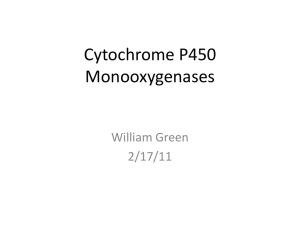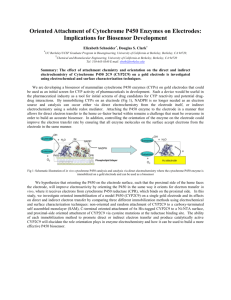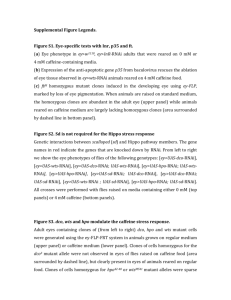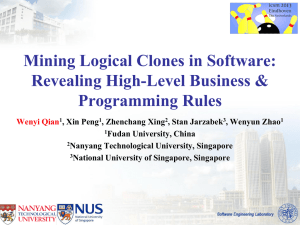File
advertisement
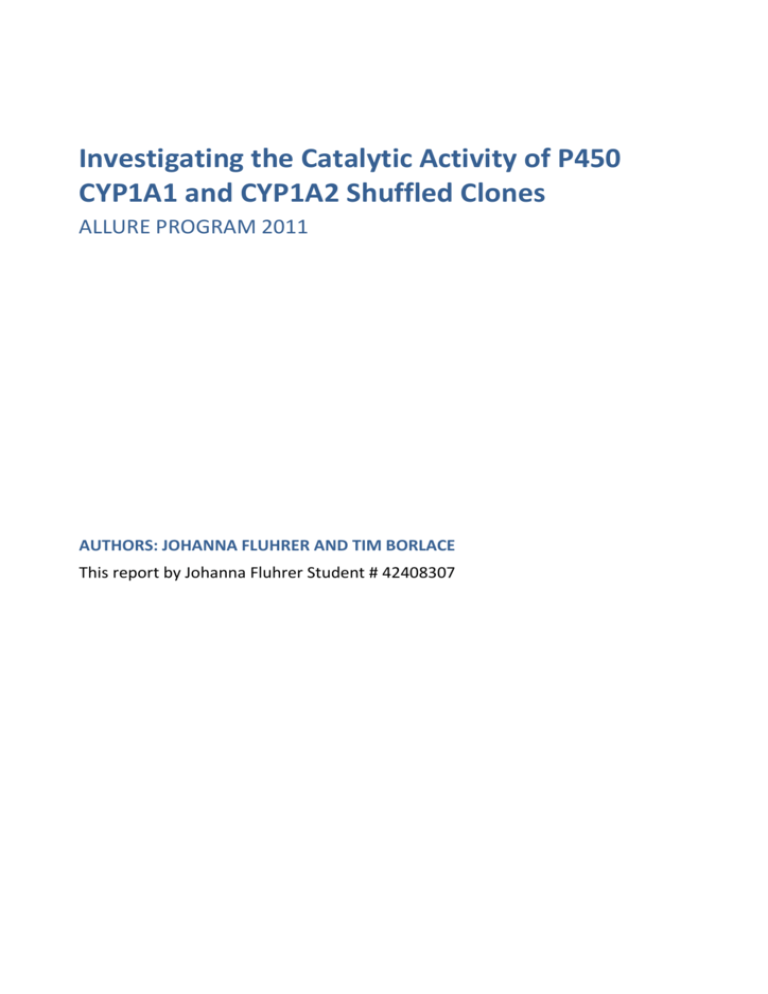
Investigating the Catalytic Activity of P450 CYP1A1 and CYP1A2 Shuffled Clones ALLURE PROGRAM 2011 Johanna Fluhrer AUTHORS: JOHANNA FLUHRER AND TIM BORLACE This report by Johanna Fluhrer Student # 42408307 Investigating the Catalytic Activity of P450 CYP1A1 and CYP1A2 Shuffled Clones ALLURE PROGRAM 2011 – J. FLUHRER 42408307 SUMMARY INTRODUCTION Cytochrome P450 are enormously versatile enzymes that span across numerous hemecontaining monooxygenase families (Bernhardt, 2006). In eukaryotic cells, they are primarily involved in biosynthesis and xenobiotic biotransformation (Bernhardt, 2006; Myasoedova, 2008). To date, over 5,000 P450 genes have been cloned and classified (Bernhardt 2006). The catalytic power of P450 has become a hot topic in biotechnology (Bernhardt 2006). Cytochrome P450 In the University of Queensland ALLURE program, biochemistry students studied a previously generated library of shuffled P450 isoforms CYP1A1 and CYP1A2. Students completed whole-cell assays to test the bioactivity of the clones. Five clones were assigned for characterisation and analysis. Our intention was to determine the catalytic activity and genomic integrity of the shuffled clones. Our interest was in the capability of the clones to display the following properties: expression of P450 enzymes, catabolysis of luciferin-CEE, production of indigo pigment through indoxyl catalysis, participation in the O-dealkylation of 7-benzyloxyresorufin (BROD). Also of interest were genomic features of the clones elucidated through sequencing and bioinformatics analysis. The presence of P450 in the five assigned clones #1, #6, #122, #126 and #188 was confirmed through expression profiling and SDS-PAGE, and also through sequence analysis. Minimal levels of indigo production were detected from all clones. Clones #1 and #6 were able to catalyse 20µM Luciferin-CEE to ~1.75µM luciferin in a luminescent assay. The substrate BROD was unable to be converted by any of the clones. Successful P450 expression in the clones indicates the maintenance of some structural integrity despite the genomic shuffling. Some function of the parental clones 1A1 and 1A2 was maintained in clones #1 and #6. Further investigation into the catalytic potential of these clones may elucidate other features of their promiscuity. Cytochrome P450s are a taxonomically ubiquitous enzyme that possess broad substrate specificity (Myasoedova, 2008). They are a super family of monoxygenase haemproteins and are usually membrane-bound (Myasoedova 2008). The name ‘Cytochrome’ is indicative of their hemoprotein properties, and ‘P450’ is derived from their spectral properties: the CO-bound complex has a maximum absorbtion peak at 450nm (Bernhardt 2006) Generally, monoxygenases incorporate a single oxygen atom into a substrate, simultaneously reducing a second oxygen atom to water (Bernhardt 2006). P450 isoform CYP1A1 and its relation CYP1A2 are members of the enzyme superfamily and share 74% DNA-sequence similarity. Interestingly, their function and expression profile differ significantly (Stiborov et al. 2001). Both proteins are known to break down carcinogenic intermediates of polycyclic aromatic hydrocarbons, which are compounds in cigarette smoke (Stiborov· et al. 2001). A related family member, isoform CYP1A2 furthermore accepts caffeine, fluorescent resorufins, aflatoxin B1, heterocyclic aromatic amines and acetaminophen substrates (Myasoedova 2008). The diverse catabolyic activity of P450 enzymes is continuosly being researched. The primary feature of P450 is their capacity for xenobiotic metabolism, i.e., they can catabolyse substrates that are foreign to the organism. These include toxins, drugs and pollutants. Table 1 shows lists of the types of reactions that P450 cytochromes catalyse, and a list of acceptable substrates. The far stretching range of synthetic reactions catalysed by P450 opens up their potential use in biotechnology (Bernhardt 2006). Despite the extensive potential P450 enzymes exhibit, their low catalytic activity, instability and complexity have arisen as barriers to their biotechnological efficacy (Bernhardt 2006). There is emerging potential for P450 enzymes to be applied in whole-cell biocatalysis, specifically in the technique of engineering directed evolution (Bernhardt 2006; Johnston et al. 2007). Investigating the Catalytic Activity of P450 CYP1A1 and CYP1A2 Shuffled Clones 2 Investigating the Catalytic Activity of P450 CYP1A1 and CYP1A2 Shuffled Clones ALLURE PROGRAM 2011 – J. FLUHRER 42408307 can be used to digest the genomic content non-randomly, and PCR reactions can be used to piece together a novel gene from these fragments. This gene will consist of a random arrangement of genomic material and can be cloned into a vector, such as Escherida Coli. The idea is that the native genomic structure of the parent isoform is not maintained, and the reshuffling of its gene fragments creates a novel, mutant clone. A hybrid library of mutants can be screened to test for structural integrity and functional activity of the recombinant clone (Johnston et al. 2007). Should novel activity be detected in the shuffled clones, the assay can then be used as a springboard in investigating and establishing directed evolution of the enzyme. The ALLURE objective Catalytic Promiscuity Traditionally, enzymes have been understood to be highly specific for the one reaction that they catalyse (Nath & Atkins 2008). Recently, the well-established yet under-acknowledged notion of catalytic promiscuity is being more broadly discussed (Khersonsky & Tawfik 2010). Catalytic promiscuity describes coincidental conversion of substrates that are different to the substrate for which the enzyme evolved. (Khersonsky & Tawfik 2010). Promiscuous enzymes may also have the capacity to convert one substrate into multiple products (Nath & Atkins 2008). Importantly, catalytic promiscuity involves catalysis of substrates that are not native to the organism, such as toxic substrates or drugs (Khersonsky & Tawfik 2010). There is a plethora of literature that discusses the evolutionary significance of promiscuous enzymes. It is understood that these versatile catalysts potentiate new evolutionary functions (Nath & Atkins 2008). In ALLURE, we used previously generated recombinant E. coli as host microorganisms expressing P450 in a whole-cell assays. We studied a library of clones shuffled from P450 parental isoforms 1A1 and 1A2. This paper describes assays performed on five of these clones: #1, #6, #122, #126 and #188. P450 is not native to E. coli, thus, plasmids that encoded these shuffled genes included hPNR to facilitate expression. These plasmids were transformed into the recombinant E.coli and libraries created in preparation for ALLURE. The characterisation and catalytic activity of these shuffled clones was studied as follows Genomic characterisation of shuffled clones: Plasmid DNA extraction and electrophoresis; Molecular weight of recombinant P450; Sequencing of plasmid DNA; Bioinformatic analysis of the shuffled genes Catalytic activity of shuffled clones: Production of indigo pigment via indoxyl catabolism; Luciferin metabolism; Resorufin metabolism Shuffled enzyme libraries A ‘shuffled library’ is one in which parental isoforms of genes are shuffled at the genomic level. In ALLURE, the parental isoforms were CYP1A1 and CYP1A2. Restriction-enzymes Investigating the Catalytic Activity of P450 CYP1A1 and CYP1A2 Shuffled Clones 3 Investigating the Catalytic Activity of P450 CYP1A1 and CYP1A2 Shuffled Clones ALLURE PROGRAM 2011 – J. FLUHRER 42408307 RESULTS Measuring P450 expression of samples SDS-PAGE: P450 is not native to E. coli. We confirmed P450 expression in the recombinant mutants using Sodium Dodecyl Sulphate Polyacrilamide Gel Electrophoresis (SDS-PAGE). SDS-PAGE separates protein on the basis of their size. Figure 1 demonstrates the presence of P450 in and indicates the weight to be 5pmol. Sequencing of Shuffled Clones Plasmid DNA was extracted from shuffled clones #1 and #188 using a QIAprep kit™. The presence and quality of DNA was demonstrated by electrophoresis. Unfortunately the quality of the DNA extracted was compromised (A260:A280 was 27.5 and -0.61 respectively) Spectrophotometry was used to quantitate DNA and determine the amount to send for sequencing. Results from #1 were unreadable. #188 was sequenced successfully for 700 nucleotides using a forward primer and for 344 nucleotides using a reverse primer (see appendix). Construction of a contigous sequence from the two sequencing reactions was impossible due to the short length of readable sequence. Bioinformatic analysis of the sequence and of CYP1A1 and CYP1A2, and #188 produced the following results: Prior to other assays, P450 expression was also measured by tutor James Behrendorff. These are outlined in Table 2. P450 expression profiling confirmed the presence of P450 enzymes in the control cells and their recombinant clones. The overall trend seems to be that the clones produced more P450 than the parental isoforms. * Using PROSITE (ExPASSy.org): CYP1A1 and CYP1A2 both contain a P450 cystein-hemeiron ligand signature motif. The active site is situated at 512aa in 1A1 and at 516aa in 1A2. The site consists of the amino acid sequence: FGMGKRKCIG. Upon translating the #188 sequence in 6 frames, this sequence was not present. * BLASTx was used to determine whether the 188 sequence contained any recognisable protein sequences. Significant alignments included detection of cytochrome P450 Investigating the Catalytic Activity of P450 CYP1A1 and CYP1A2 Shuffled Clones 4 Investigating the Catalytic Activity of P450 CYP1A1 and CYP1A2 Shuffled Clones ALLURE PROGRAM 2011 – J. FLUHRER 42408307 [Homo Sapiens], with most prominent isoform sequence detected being CYP2C9 (Sigrist et al. 2010). Further analysis and resequencing may confirm whether clone #188 has been shuffled to resemble this P450 isoform. * Sequence similarity search using BLASTn: Identicle sequences were found in 18 regions of the 1A1, 1A2 and #188 sequences. The identity of these sequences ranged from between 63-100%. Much structural integrity was maintained, however, there were a few matches between the 1A1/1A2 and the clone that were in very different genomic positions. This confirms the clone #188 as a shuffled clone of CYP1A1/1A2. Indoxyl, a product of tryptophan metabolism in E. coli is metabolised by P450 to produce indigo in recombinant bacterium. Controls (1A1, 1A2, hPNR) and shuffled clones 1, 6, 122, 126 and 188 were tested for their ability to produce indigo pigment in solid and liquid agar in two separate assays. Slight indigo production was detected from all clones in the liquid agar assay (see Figure 2) though it was undetectable in solid agar. This may be a limitation of the solid agar as a medium for this assay. Luminescence Screening for indigo production in solid and in liquid culture concentrations. The standard curve was successful in both a preliminary assay (luciferin 0µM-50µM) and in the final assay (luciferin 0µM-5µM). Figure 3 shows standard curve and luminescence of clones in the final assay. In both the preliminary and final attempts, clones 1 and 6 displayed activity, with product concentrations equivalent to approximately1.7µM and 1.8µM respectively. There was no detectable activity in the other Controls and clones Luciferin (µM) Figure 3: Luminescence of controls (1A1, 1A2, hPNR) and shuffled clones (, #6, #122, #126, #188) in the final Luciferin metabolism assay. Activity in in clones #1 and #6 suggest convertion of 20µM substrate to approximately 1.7µM and 1.8µM luciferin product in the respective clones clones. Screening for Luciferin Metabolism Some P450 isoforms are able to catabolise Luciferin-CEE to product luciferin in a luminescent reaction. The intensitiy of luminescence produced is a function of the concentration of reaction product. Thus, measurements of luminescence were compared to a standard curve of known Screening for O-Dealkylation via 7benzyloxyresorufin metabolism Shuffled clones were tested for their ability to metabolise probe-substrate 7benzyloxyresorufin (BROD) in a fluorescent assay. Conversion of BROD to resorufin is an oxidative dealkylation reaction known to be a Investigating the Catalytic Activity of P450 CYP1A1 and CYP1A2 Shuffled Clones 5 Investigating the Catalytic Activity of P450 CYP1A1 and CYP1A2 Shuffled Clones ALLURE PROGRAM 2011 – J. FLUHRER 42408307 marker of CYP3A isoform induction. There was no detectable activity in the preliminary assay, nor was there detectable activity in the final assay. Adjustments to the preliminary assay included an internal standard and tightening up of sequence reaction times. Also, the final assay included isoform CYP3A as a control, however, it also did not display detectable activity, suggesting the experimental procedure be revised. Generally, the P450 expression profile was comparable between the preliminary and final assay. DISCUSSION Cytochrome P450 is an extraordinary diverse gene family which contains over 5,000 isoforms. CYP1A1 and CYP1A2 are members of this family, and are known for their mutual ability to produce indigo, convert luciferinCEE to lucifern, and catabolise carcinogenic intermediates of cigarette smoke (Stiborov· et al. 2001). 1A2 has the further capacity to accept caffeine, fluorescent resorufins, aflatoxin B1, heterocyclic aromatic amines and acetaminophen substrates. In ALLURE, we were able to complete whole cell assays of five shuffled clones from parental isoforms CYP1A1 and CYP1A2. Luciferin metabolism was maintained in at least two clones ( #1 and #6). Indigo production was minimal in all five clones. No clones were able to participate in resorufin metabolism, however, there was also no activity in the positive controls, deeming the results inconclusive. There were technical aspects of the assays that are worth considering in terms of result analysis. Inconclusive results in the assay testing resorufin metabolism could be of great interest. The O-dealkylation of BROD is a specific marker that assigns induction of P450 isoform CYP3A by xenobiot compounds (Stiborov· et al. 2001). CPY3A isoforms are responsible for 50% of the human metabolism of clinical drugs. Apart from in the liver, CYP3A human isoforms influence endocrine function by mediating androgen level and signalling in the brain. Conversion of BRODresorufin is an oxidative dealkylation reaction that is selective for 3A enzymes. The parental isoforms (1A1, 1A2) of our clones are not known to participate in this reaction, thus, it would have been an enormous surprise had their genes been shuffled in a way that confers BROD dealkylation to clones. However, using CYP3A as a positive control in the final assay did not confirm these speculations as the control results were negligible. Further investigation into the Odealkylative activity of the clones is required. Assays on the purified P450 protein fractions rather than on the whole cells may provide further information. P450 genes are approximately 2,500 base pairs (bps) in length. Sequencing reactions of the shuffled clones produced between 340-700bps of quality sequence. Despite this, sequence similarity searches identified clone #188 as similar (100%) to Cytochrome P450 gene family. Unfortunately the heme-ligand binding site was not confirmed present in the short lengths of the #188 sequence. We assume that the short clone sequence did not cross over the usual site at which the signature motif appears. We predict that the signature motif exists in a part of the DNA that unfortunately was unable to sequenced successfully. Shuffling of 1A1 and 1A2 in the clone #188 was confirmed using sequence similarity search tools. Regions of up to 30 nucleotides in length were 63-100% identical. There was no pattern as to where on the parental isoform genome these matching sequences were existed. This suggests that the shuffling of DNA happened in random orientation in the clones. Interestingly, the isoform that #188 seems most similar to is one that is alternate to its parental strains 1A1 and 1A2. The isoform that #188 is most similar to is CYP2C9. The catalytic of CYP2C9 is quite different from the CYP1A1 and CYP1A2 from which #188 is derived. 2C9 is induced into activity by rifampim. The xenobiotics it metabolises include S-warfarin, ibuprofen, phenytoin, and tolbutamide. Furthermore, 2C9 is suggested to be polymorphic. Variants of the gene are often expressed in poor metabolisers of phenytoin and tolbutamide (Nelson et al. 2004). Investigations of the catabolic activity of clone #188 in relation to the 2C9 isoform may elucidate novel properties possessed by the clone that are not native to parental isoforms. Such further study may prove useful for directing the evolution of P450 clones and the biotechnological advantage they may confer. Investigating the Catalytic Activity of P450 CYP1A1 and CYP1A2 Shuffled Clones 6 Investigating the Catalytic Activity of P450 CYP1A1 and CYP1A2 Shuffled Clones ALLURE PROGRAM 2011 – J. FLUHRER 42408307 EXPERIMENTAL PROCEDURES Recombinant library: Recombinant E. coli library were previously produced as described in Johnston et. al 2007 (Johnston et al. 2007)(Johnston et al. 2007). Maintenance of this library was performed by tutor James Behrendorff and UQ laboratory staff. P450 expression profiling: This was done by tutor James Behrendorff in preparation for each ALLURE practical SDS-PAGE: This technique separates proteins based on their size as follows: prior to electrophoresis, the proteins are treated with SDS and heated in order to denature quarternary and tertiary structures. SDS confers a negative charge on the protein relative to the length of the polypeptide. Proteins in the sample are thus separated by size. Materials and methods as per ALLURE practical manual. DNA minipreps: Plasmid DNA extracted for sequencing was achieved using using QIAprep kit. Protocol as per ALLURE practical manual. DNA Sequencing: Forward and reverse primers were designed by UQ staff. Sequencing was performed externally. Indigo Production: As per ALLURE prac manual Luciferin metabolism: Standard curve set up included luciferin concentrations of 0µM, 2.5µM, 5µM, 10µM 25µM and 50µM in the preliminary assay, and concentrations of 0µM, 1.25µM, 2.5µM, 3.75µM and 5µM in the final assay. Luminescent assay with 45µL cells (controls1A1, 1A2, hPNR; clones 1, 6, 122, 126, 188), 5µL of 300µM stock luciferin-CEE substrate. Incubation for 20mins 45mins was at 37ºC/700rpm. Reactions were stopped by the addition of 20µL luciferase. Other than the standard curve set up, the final assay proceeded as per the preliminary. BROD catabolyic assay: Instead of 2mM substrate solution as prescribed in the ALLURE prac manual, a 1mM BROD solution was used. Successful standard curve was created using resorufin concentrations of 0µM, 2.5µM, 5µM, 10µM, 15µM and 20µM. Fluorescent assay with 40µL cells in a 100µL reaction volume: controls 1A1, 1A2, hpNR cells; mutant clones 1, 6, 122, 126, and 188; substrate: 20µM concentration of 1mM BROD in 50% methanol; and buffer. Assay was incubated for 30mins at 37C before reaction was stopped by the addition of 100µL cold methanol. Fluorescence measured with ex=530nm, em=582nm. Additional procedures in the final assay included the set up of an an internal standard, tightening of reaction time, and an additional control isoform CYP3A. ACCESSION NUMBERS: CYP1A1: NC_000015; CYPA12: NM_000761 ACKNOWLEDGEMENTS James Behrendorff, tutor and mentor of the ALLURE program. James maintained the shuffled libraries, prepared samples of clones, performed expression profiling and undertook the laboratory work necessary to facilitate assays achieved in ALLURE. During and inbetween practicals, James was always available for discussion and was always encouraging and patient in the way he advised students. I felt honoured to be under his tutelage. Susan Rowland: organising the grant, scripting and coordinating the ALLURE program. Susan has been critical in establishing the opportunity for my fellow students and I to partake in real research experience. Laboratory partner Tim Borlace who worked professionally and efficiently in the laboratory. Collaborating with Tim has been an invaluable learning experience. Tim also completed the final Luciferin assay entirely without my assistance and was extremely willing to share his ideas and results with regards to this assay. Laboratory staff for assisting James with the preparation and facilitation of the programme. Fellow ALLURE students for their active contribution to discussions and continuous encouragement University of Queensland – Thank you incorporating the ALLURE program into the biochemistry curriculum. APPENDIX Investigating the Catalytic Activity of P450 CYP1A1 and CYP1A2 Shuffled Clones 7 Investigating the Catalytic Activity of P450 CYP1A1 and CYP1A2 Shuffled Clones ALLURE PROGRAM 2011 – J. FLUHRER 42408307 SEQUENCING RESULTS From the forward primer: TCCTGGCCCCACTCCTCTCCCAGTGAT TGGAAATATCCTACAGATAGGTATTAAG GACATCAGCAAATCCTTAACCAATCTCT CAAAGGTCTATGGCCCTGTGTTCACTCT GTATTTTGGCCTGAAACCCATAGTGGTG CTGCATGGATATGAAGCAGTGAAGGAA GCCCTGATTGATCTTGGAGAGGAGTTTT CTGGAAGAGGCATTTTCCCACTGGCTG AAAGAGCTAACAGAGGATTTGGAATTGT TTTCAGCAATGGAAAGAAATGGAAGGA GATCCGGCGTTTCTCCCTCATGACGCT GCGGAATTTTGGGATGGGGAAGAGGAG CATTGAGGACCGTGTTCAAGAGGAAGC CCGCTGCCTTGTGGAGGAGTTGAGAAA AACCAAGGCCTCACCCTGTGATCCCAC TTTCATCCTGGGCTGTGCTCCCTGCAAT GTGATCTGCTCCATTATTTTCCATAAAC GTTTTGATTATAAAGATCAGCAATTTCTT AACTTAATGGAAAAGTTGAATGAAAACA TCAAGATTTTGAGCAGCCCCTGGATCC AGATCTGCAATAATTTTTCTCCTATCATT GATTACTTCCCGGGAACTCACAACAAAT TACTTAAAAACGTTGCTTTTATGAAAAG TTATATTTTGGAAAAAGTAAAAGAACAC CAAGAATCAATGGACATGAACAACCCT Sequencing results from the reverse Promer CAACCATATTAATTTCCCTGACTTCTGT GCTACATGACAACAAAGAATTTCCCAAC CCAGAGATGTTTGACCCTCATCACTTTC TGGATGAAGGTGGCAATTTTAAGAAAAG TAAATACTTCATGCCTTTCTCAGCAGGA AAACGGATTTGTGTGGGAGAAGCCCTG GCCGGCATGGAGCTGTTTTTATTCCTGA CCTCCATTTTACAGAACTTTAACCTGAA ATCTCTGGTTGACCCAAAGAACCTTGAC ACCACTCCAGTTGTCAATGGATTTGCCT CTGTGCCGCCCTTCTACCAGCTGTGCT TCATTCCTGTGTCGACCCATCATCATCA TCATCATTGA REFERENCE: Bernhardt, R. (2006). Cytochromes P450 as versatile biocatalysts. J Biotechnol. 124, 128-45. Johnston, W.A., Huang, W., De Voss, J.J., Hayes, M.A. & Gillam, E.M. (2007). A shuffled CYP1A library shows both structural integrity and functional diversity. Drug Metab Dispos. 35, 21772185. Khersonsky, O., and Tawfik, D.S. (2010). Enzyme promiscuity: a mechanistic and evolutionary perspective. Annu Rev Bioche 79, 471-505. Mathias, A., Kisdi, A., Olivieri, I. (2001). Divergent evolution of dispersal in a heterogeneous landscape. Evolution 55, 246-59. Myasoedova, K.N. (2008). New findings in studies of cytochromes P450. Biochemistry (Mosc) 73, 965-969. Nath, A., and Atkins, W.M. (2008). A quantitative index of substrate promiscuity. Biochemistry 47, 157-166. Nelson, D.R., Zeldin, D.C., Hoffman, S.M., Maltais, L.J., Wain, H.M. and Nebert, D.W. (2004). Comparison of cytochrome P450 (CYP) genes from the mouse and human genomes, including nomenclature recommendations for genes, pseudogenes and alternative-splice variants. Pharmacogenetics 14, 1-18. Sigrist, C., Cerutti, L., de Castro, E., LangendijkGenevaux, P., Bulliard, V., Bairoch, A., and Hulo, N. (2010). PROSITE, a protein domain database for functional characterization and annotation. Nucleic Acids Research 38, 161-166. Stiborov, M., Frei, E., Wiessler, M., and Schmeiser, H.H. (2001). Human enzymes involved in the metabolic activation of carcinogenic aristolochic acids: evidence for reductive activation by cytochromes P450 1A1 and 1A2. Chemical research in toxicology 14, 1128-37. Investigating the Catalytic Activity of P450 CYP1A1 and CYP1A2 Shuffled Clones 8
